Abstract
The effect of mouse fibroblast interferon on Salmonella typhimurium infection in infant mice was examined. The lethality to mice that had been given S. typhimurium intragastrically was significantly reduced in a dose-dependent manner when the mice were pretreated with fibroblast interferon. Lower doses of interferon delayed the development of disease. Interferon neutralized with anti-interferon globulin did not influence the lethality of S. typhimurium to mice. In mice treated with interferon there was also a reduced invasiveness of S. typhimurium in intestinal epithelial cells in vivo. It was further demonstrated in an in vitro system that interferon pretreatment of mouse L-929 cells inhibited the invasiveness of the bacteria in a dose-dependent manner. The in vitro inhibition was neutralized with anti-interferon globulin. The results indicate that interferon inhibits Salmonella bacteria from invading cells and establishing an intracellular state of infection. This may represent an important factor in the pathogenesis of disease.
Full text
PDF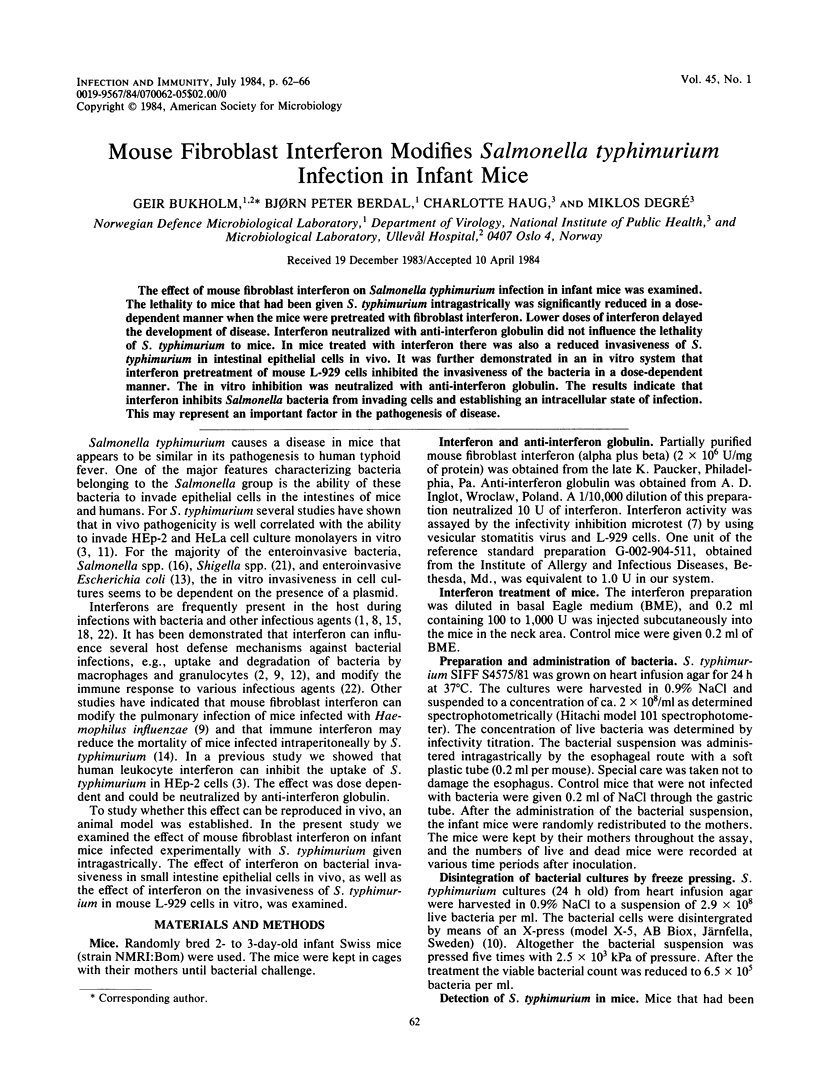
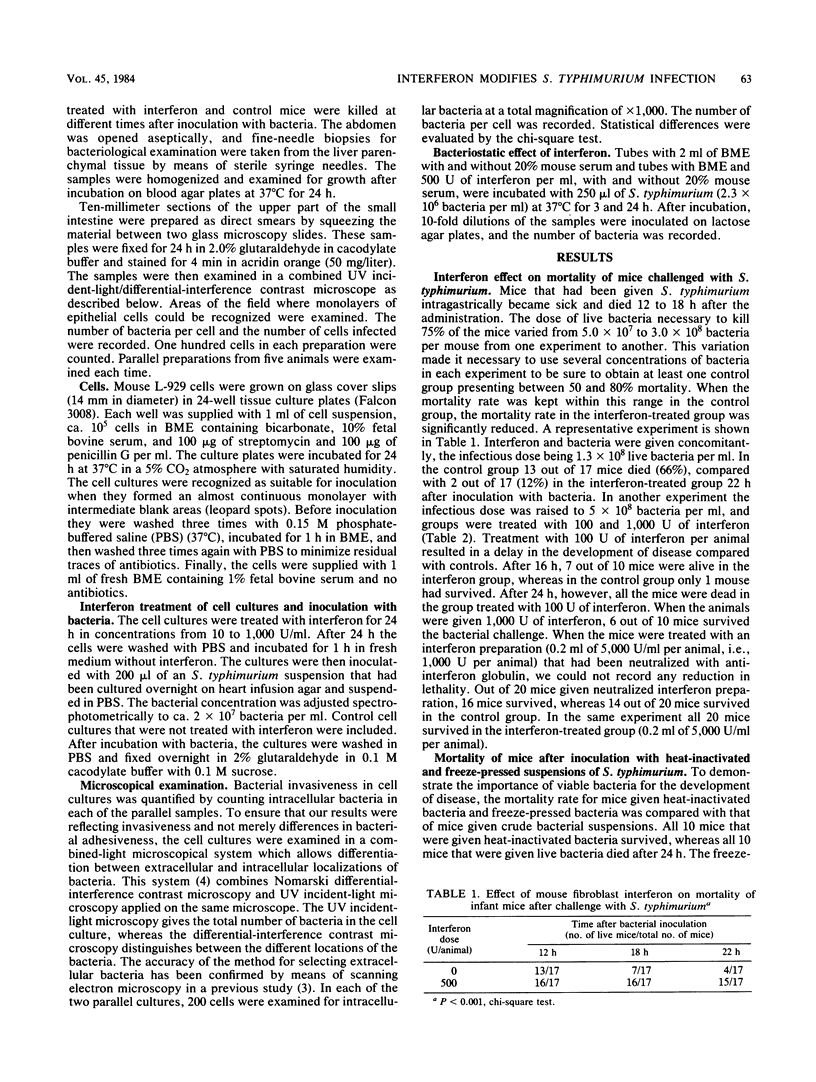
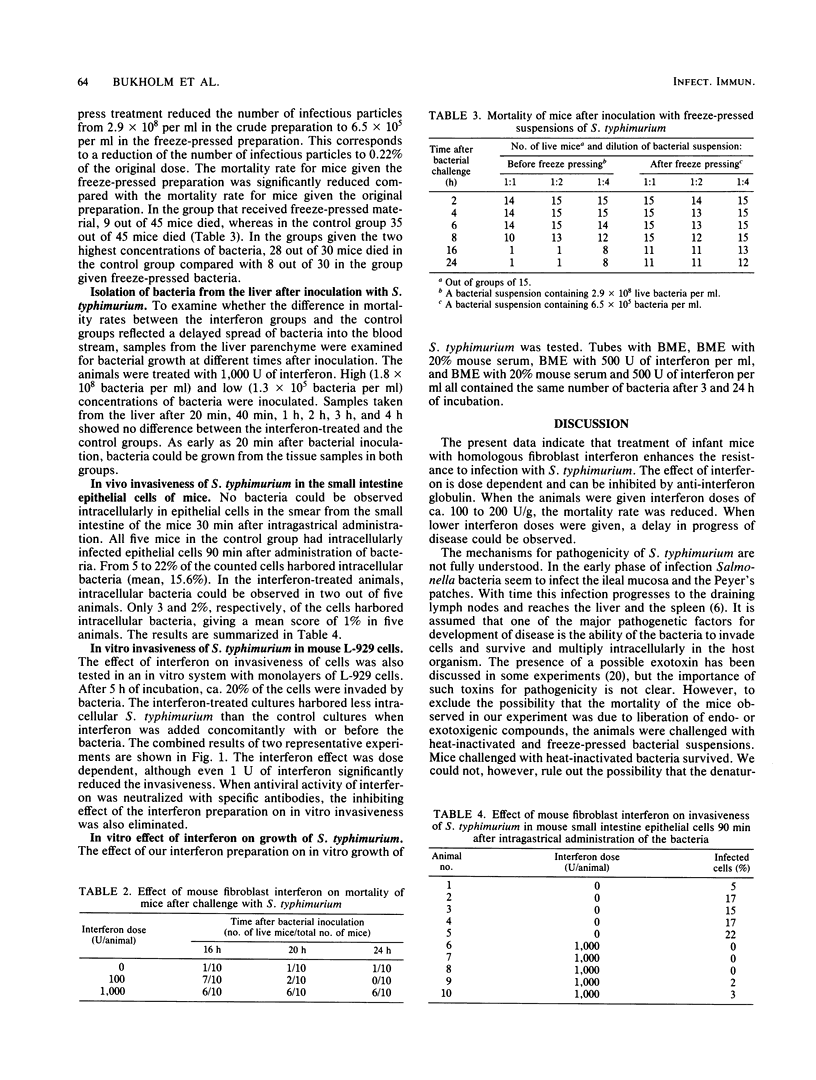
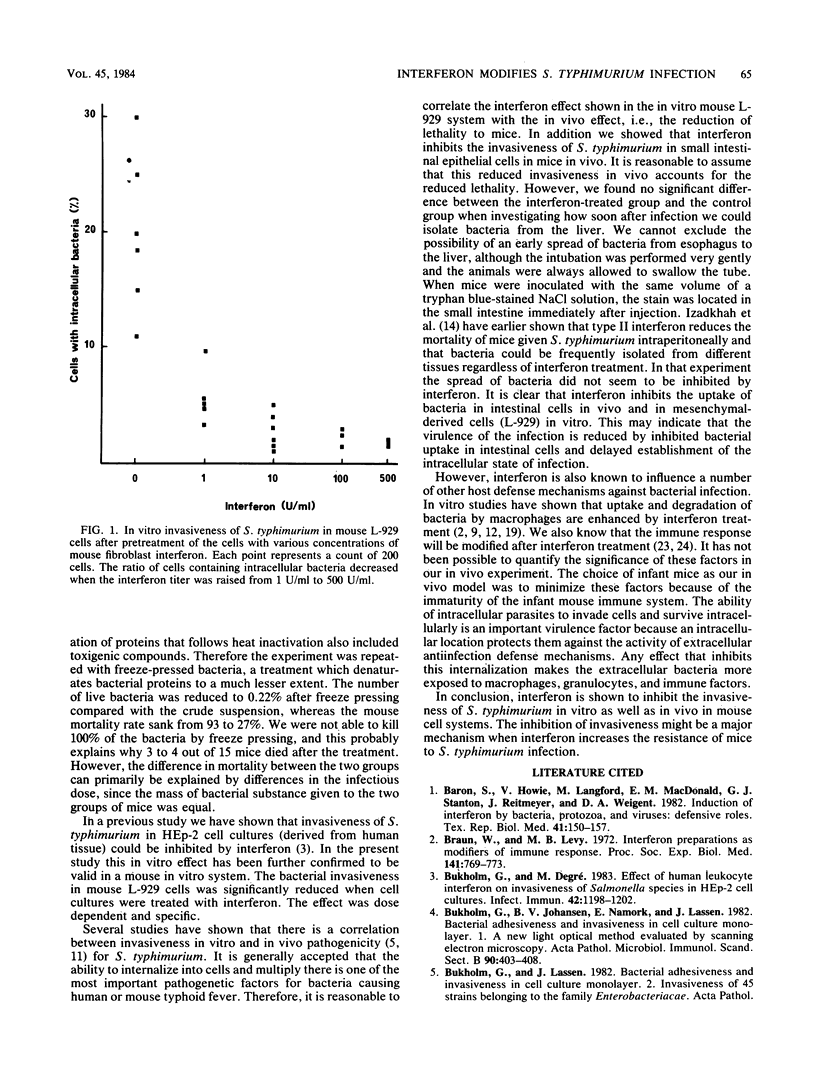
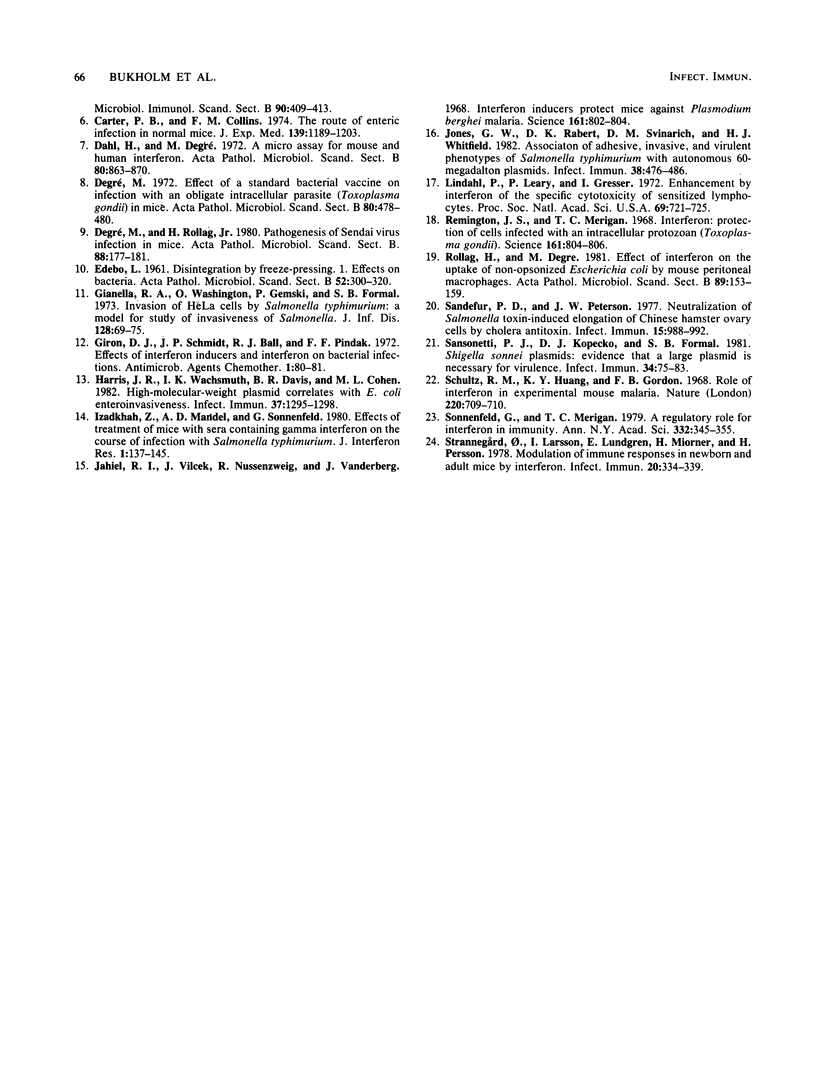
Selected References
These references are in PubMed. This may not be the complete list of references from this article.
- Baron S., Howie V., Langford M., Macdonald E. M., Stanton G. J., Reitmeyer J., Weigent D. A. Induction of interferon by bacteria, protozoa, and viruses: defensive role. Tex Rep Biol Med. 1981;41:150–157. [PubMed] [Google Scholar]
- Braun W., Levy H. B. Interferon preparations as modifiers of immune responses. Proc Soc Exp Biol Med. 1972 Dec;141(3):769–773. doi: 10.3181/00379727-141-36868. [DOI] [PubMed] [Google Scholar]
- Bukholm G., Degré M. Effect of human leukocyte interferon on invasiveness of Salmonella species in HEp-2 cell cultures. Infect Immun. 1983 Dec;42(3):1198–1202. doi: 10.1128/iai.42.3.1198-1202.1983. [DOI] [PMC free article] [PubMed] [Google Scholar]
- Bukholm G., Johansen B. V., Namork E., Lassen J. Bacterial adhesiveness and invasiveness in cell culture monolayer. Acta Pathol Microbiol Immunol Scand B. 1982 Dec;90(6):403–408. doi: 10.1111/j.1699-0463.1982.tb00138.x. [DOI] [PubMed] [Google Scholar]
- Carter P. B., Collins F. M. The route of enteric infection in normal mice. J Exp Med. 1974 May 1;139(5):1189–1203. doi: 10.1084/jem.139.5.1189. [DOI] [PMC free article] [PubMed] [Google Scholar]
- Dahl H., Degré M. A micro assay for mouse and human interferon. Acta Pathol Microbiol Scand B Microbiol Immunol. 1972;80(6):863–870. doi: 10.1111/j.0365-5563.1973.tb00012.x. [DOI] [PubMed] [Google Scholar]
- Degré M. Effect of a standard bacterial vaccine on infection with an obligate intracellular parasite (Toxoplasma gondii) in mice. Acta Pathol Microbiol Scand B Microbiol Immunol. 1972;80(3):478–480. doi: 10.1111/j.1699-0463.1972.tb00064.x. [DOI] [PubMed] [Google Scholar]
- Degré M., Rollag H., Jr Pathogenesis of Sendasi virus infection in mice. On the possible role of interferon on the development of disease. Acta Pathol Microbiol Scand B. 1980 Jun;88(3):177–181. [PubMed] [Google Scholar]
- EDEBO L. Disintegration by freeze-pressing. 1. Effects on bacteria. Acta Pathol Microbiol Scand. 1961;52:300–320. doi: 10.1111/j.1699-0463.1961.tb01557.x. [DOI] [PubMed] [Google Scholar]
- Giannella R. A., Washington O., Gemski P., Formal S. B. Invasion of HeLa cells by Salmonella typhimurium: a model for study of invasiveness of Salmonella. J Infect Dis. 1973 Jul;128(1):69–75. doi: 10.1093/infdis/128.1.69. [DOI] [PubMed] [Google Scholar]
- Giron D. J., Schmidt J. P., Ball R. J., Pindak F. F. Effect of interferon inducers and interferon on bacterial infections. Antimicrob Agents Chemother. 1972 Jan;1(1):80–81. doi: 10.1128/aac.1.1.80. [DOI] [PMC free article] [PubMed] [Google Scholar]
- Harris J. R., Wachsmuth I. K., Davis B. R., Cohen M. L. High-molecular-weight plasmid correlates with Escherichia coli enteroinvasiveness. Infect Immun. 1982 Sep;37(3):1295–1298. doi: 10.1128/iai.37.3.1295-1298.1982. [DOI] [PMC free article] [PubMed] [Google Scholar]
- Izadkhah Z., Mandel A. D., Sonnenfeld G. Effect of treatment of mice with sera containing gamma interferon on the course of infection with Salmonella typhimurium strain LT-2. J Interferon Res. 1980 Fall;1(1):137–145. doi: 10.1089/jir.1980.1.137. [DOI] [PubMed] [Google Scholar]
- Jahiel R. I., Vilcek J., Nussenzweig R., Vanderberg J. Interferon inducers protect mice against plasmodium berghei malaria. Science. 1968 Aug 23;161(3843):802–804. doi: 10.1126/science.161.3843.802. [DOI] [PubMed] [Google Scholar]
- Jones G. W., Rabert D. K., Svinarich D. M., Whitfield H. J. Association of adhesive, invasive, and virulent phenotypes of Salmonella typhimurium with autonomous 60-megadalton plasmids. Infect Immun. 1982 Nov;38(2):476–486. doi: 10.1128/iai.38.2.476-486.1982. [DOI] [PMC free article] [PubMed] [Google Scholar]
- Lindahl P., Leary P., Gresser I. Enhancement by interferon of the specific cytotoxicity of sensitized lymphocytes. Proc Natl Acad Sci U S A. 1972 Mar;69(3):721–725. doi: 10.1073/pnas.69.3.721. [DOI] [PMC free article] [PubMed] [Google Scholar]
- Remington J. S., Merigan T. C. Interferon: protection of cells infected with an intracellular protozoan (Toxoplasma gondii). Science. 1968 Aug 23;161(3843):804–806. doi: 10.1126/science.161.3843.804. [DOI] [PubMed] [Google Scholar]
- Rollag H., Degré M. Effect of interferon preparations on the uptake of non-opsonized Escherichia coli by mouse peritoneal macrophages. Acta Pathol Microbiol Scand B. 1981 Jun;89(3):153–159. doi: 10.1111/j.1699-0463.1981.tb00169_89b.x. [DOI] [PubMed] [Google Scholar]
- Sandefur P. D., Peterson J. W. Neutralization of Salmonella toxin-induced elongation of Chinese hamster ovary cells by cholera antitoxin. Infect Immun. 1977 Mar;15(3):988–992. doi: 10.1128/iai.15.3.988-992.1977. [DOI] [PMC free article] [PubMed] [Google Scholar]
- Sansonetti P. J., Kopecko D. J., Formal S. B. Shigella sonnei plasmids: evidence that a large plasmid is necessary for virulence. Infect Immun. 1981 Oct;34(1):75–83. doi: 10.1128/iai.34.1.75-83.1981. [DOI] [PMC free article] [PubMed] [Google Scholar]
- Schultz W. W., Huang K. Y., Gordon F. B. Role of interferon in experimental mouse malaria. Nature. 1968 Nov 16;220(5168):709–710. doi: 10.1038/220709a0. [DOI] [PubMed] [Google Scholar]
- Sonnenfeld G., Merigan T. C. A regulatory role for interferon in immunity. Ann N Y Acad Sci. 1979;332:345–355. doi: 10.1111/j.1749-6632.1979.tb47128.x. [DOI] [PubMed] [Google Scholar]
- Strannegård O., Larsson I., Lundgren E., Miörner H., Persson H. Modulation of immune responses in newborn and adult mice by interferon. Infect Immun. 1978 May;20(2):334–339. doi: 10.1128/iai.20.2.334-339.1978. [DOI] [PMC free article] [PubMed] [Google Scholar]


